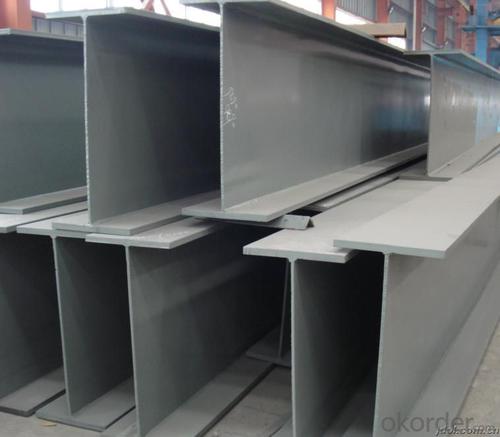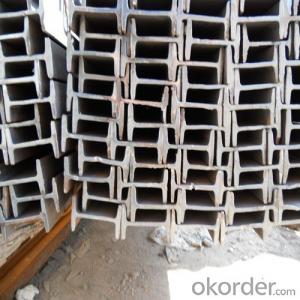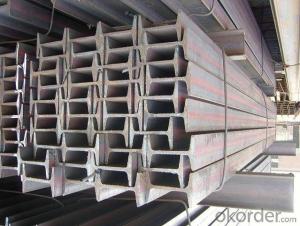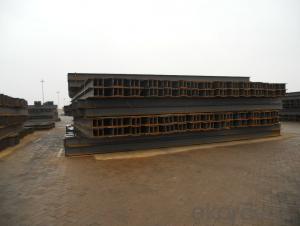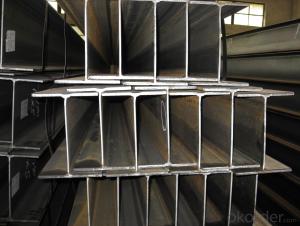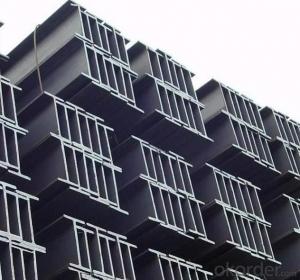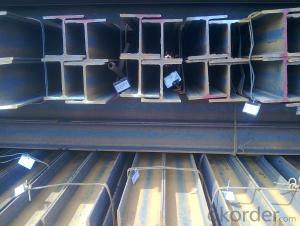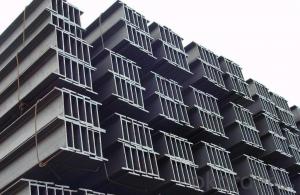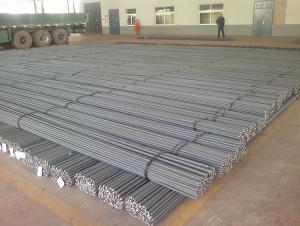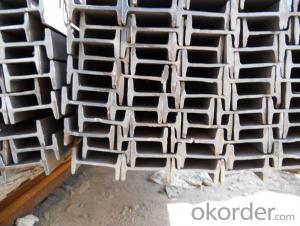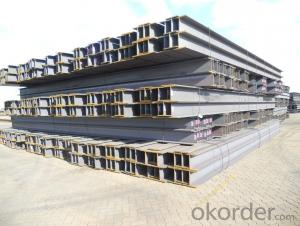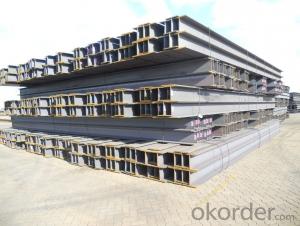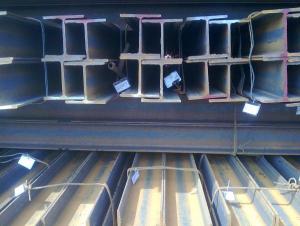GB Standard Steel H Beam 340mm-350mm with High Quality
- Loading Port:
- China main port
- Payment Terms:
- TT or LC
- Min Order Qty:
- 40 m.t
- Supply Capability:
- 15000 m.t/month
OKorder Service Pledge
OKorder Financial Service
You Might Also Like
Specifications of GB Standard Steel H Beam 340mm-350mm with High Quality For Sale:
1. Standard: GB Standard
2. Grade: Q235
3. Length: 12m
Size and Mass:
| Size (mm) | Mass (Kg/m) | Size (mm) | Mass (Kg/m) |
| 350*175*7.0 | 49.4 | 344*348*10.0 | 113 |
| 340*250*9.0 | 78.1 | 350*350*12.0 | 135 |
Usage & Applications of GB Standard Steel H Beam 340mm-350mm with High Quality For Sale:
Commercial building structure ;Pre-engineered buildings; Machinery support structure; Prefabricated structure; Medium scale bridges; Ship-building structure, etc
Packaging & Delivery of GB Standard Steel H Beam 340mm-350mm with High Quality for Building Structures:
1. Packing: it is nude packed in bundles by steel wire rod
2. Bundle weight: not more than 3.5MT for bulk vessel; less than 3 MT for container load
3. Transportation: the goods are delivered by truck from mill to loading port, the maximum quantity can be loaded is around 40MTs by each truc4. If the order quantity cannot reach the full truck loaded, the transportation cost per ton will be little higher than full load.
4. Delivered by container or bulk vessel
Production flow of GB Standard Steel H Beam 340mm-350mm with High Quality:
Material prepare (billet) —heat up—rough rolling—precision rolling—cooling—packing—storage and transportation
FAQ:
Q1: Why buy Materials & Equipment from OKorder.com?
A1: All products offered byOKorder.com are carefully selected from China's most reliable manufacturing enterprises. Through its ISO certifications, OKorder.com adheres to the highest standards and a commitment to supply chain safety and customer satisfaction.
Q2: How do we guarantee the quality of our products?
A2: We have established an advanced quality management system which conducts strict quality tests at every step, from raw materials to the final product. At the same time, we provide extensive follow-up service assurances as required.
Q3: How soon can we receive the product after purchase?
A3: Within three days of placing an order, we will arrange production. The shipping date is dependent upon the quatity, how many sizes you want and the plan of production, but is typically 1 month to 2 month days from the beginning of production.
Images of GB Standard Steel H Beam 340mm-350mm with High Quality:

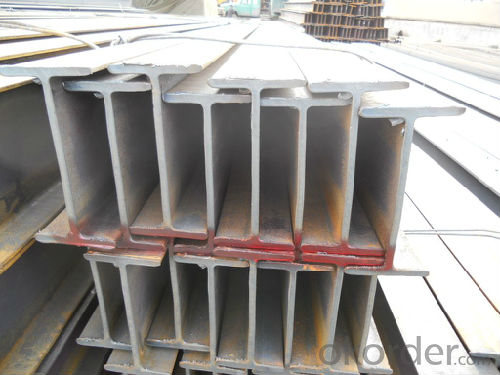
*If you would like to get our price, please inform us the size, standard/material and quantity. Thank you very much for your attention.
- Q: How do steel H-beams compare to wooden beams in terms of cost and performance?
- Steel H-beams and wooden beams differ significantly in terms of cost and performance. In terms of cost, steel H-beams tend to be more expensive than wooden beams. The cost of steel is generally higher than wood, and the fabrication and installation of steel H-beams can also be more labor-intensive and time-consuming. Additionally, steel H-beams often require specialized equipment and expertise, further adding to the overall cost. However, when it comes to performance, steel H-beams have several advantages over wooden beams. Firstly, steel is much stronger and more durable than wood. Steel H-beams can withstand higher loads and have a higher resistance to bending and warping, making them ideal for supporting heavy structures or spanning long distances. Wooden beams, on the other hand, may require additional supports or reinforcement to achieve similar load-bearing capacities. Moreover, steel H-beams are fire-resistant, unlike wooden beams which are highly flammable. This fire-resistant property makes steel H-beams a safer option for construction in areas prone to fire hazards. Additionally, steel H-beams are less prone to insect infestations, rot, and decay, which are common issues with wooden beams. This durability translates into a longer lifespan and reduced maintenance costs for structures built with steel H-beams. In conclusion, while steel H-beams tend to be more expensive than wooden beams, they offer superior performance in terms of strength, durability, fire resistance, and low maintenance. Therefore, the choice between steel H-beams and wooden beams ultimately depends on the specific requirements of the project, budget constraints, and the desired lifespan of the structure.
- Q: Are steel H-beams resistant to seismic forces?
- Yes, steel H-beams are generally resistant to seismic forces. Steel is a highly durable and strong material, making it suitable for withstanding seismic forces, such as those generated by earthquakes. H-beams, also known as I-beams, provide excellent structural support due to their shape, which distributes the load evenly along the beam's length. This shape helps to minimize the effects of seismic forces by effectively dissipating the energy and preventing excessive movement or deformation. Additionally, steel H-beams can be further reinforced with additional materials or techniques, such as cross-bracing or moment resisting frames, to enhance their seismic resistance even further. Therefore, steel H-beams are commonly used in construction projects located in earthquake-prone areas, as they offer a high level of resilience against seismic forces.
- Q: Can steel H-beams be used for cantilever structures?
- Certainly! Cantilever structures can indeed make use of steel H-beams. These structures are specifically designed to incorporate a projecting beam or member that is supported on just one end, while the other end remains free or unsupported. Steel H-beams are widely employed in the realm of construction due to their remarkable strength and ability to bear substantial loads. They are particularly well-suited for cantilever designs as they offer exceptional structural support, effectively minimizing deflection and ensuring overall stability. Nonetheless, it is imperative to take into account the specific requirements of the cantilever structure. In order to determine the appropriate size and strength of the H-beam necessary to support the desired load and span, it is highly recommended to seek guidance from a structural engineer.
- Q: How do you calculate the moment capacity of steel H-beams?
- In order to determine the moment capacity of steel H-beams, it is necessary to take into account various properties of the beam, including its dimensions and material properties. The moment capacity, also referred to as the bending strength or flexural strength, is a measure of the beam's ability to withstand bending forces. To calculate the moment capacity of a steel H-beam, the following steps can be followed: 1. Calculate the section properties: The initial step involves determining the section properties of the H-beam, such as the moment of inertia (I) and the section modulus (Z). These properties are dependent on the dimensions of the beam, including the flange width, flange thickness, web height, and web thickness. These values can be obtained from structural design manuals or the specifications provided by the manufacturer. 2. Determine the yield strength: The subsequent step is to establish the yield strength (Fy) of the steel material used in the H-beam. This value represents the maximum stress that the steel can endure without experiencing permanent deformation. The yield strength can also be obtained from design manuals or the manufacturer's specifications. 3. Calculate the plastic moment capacity: The plastic moment capacity (Mp) is the maximum moment that the beam can withstand before it begins to yield or undergo plastic deformation. It is determined by multiplying the yield strength (Fy) by the section modulus (Z). The formula for calculating the plastic moment capacity is Mp = Fy * Z. 4. Determine the allowable moment capacity: The plastic moment capacity is not always the governing factor in design. Depending on the design requirements and safety factors, the allowable moment capacity may be lower than the plastic moment capacity. The allowable moment capacity is calculated by multiplying the plastic moment capacity by a factor of safety (Fs). The factor of safety takes into account uncertainties in materials, loads, and other design considerations. The formula for calculating the allowable moment capacity is Ma = Mp * Fs. By following these steps, one can ascertain the moment capacity of steel H-beams and ensure that the beam is designed to withstand the necessary bending forces in a safe and efficient manner. It is crucial to consult design codes, standards, and principles of structural engineering to guarantee the accuracy and reliability of the calculations.
- Q: What are the design considerations for steel H-beams in coastal areas?
- Several important factors need to be considered when designing steel H-beams for coastal areas in order to ensure their durability and longevity in the harsh and corrosive environment. 1. To combat corrosion, it is crucial to select steel with excellent corrosion-resistant properties, such as stainless steel or galvanized steel. These materials have protective coatings that can withstand the corrosive nature of the coastal environment where high levels of saltwater and humidity are present. 2. The strong winds and storms commonly experienced in coastal regions exert significant forces on the H-beams. Designers should take into account the wind load and ensure that the H-beams are adequately sized and reinforced to withstand these forces. Additionally, proper connections and fasteners should be utilized to maintain the structural integrity of the H-beams during extreme weather events. 3. Erosion and scour pose a risk to the stability of the H-beams in coastal areas. It is important to consider the soil conditions and design appropriate foundations for the H-beams to mitigate this risk. Additional measures such as using extra piling or protective barriers can be implemented to prevent erosion and scour around the H-beams. 4. Regular maintenance and inspection are essential for steel H-beams in coastal areas due to the harsh environment. This includes periodic cleaning, repainting, and inspection for signs of corrosion or damage. Implementing a diligent maintenance plan will help extend the lifespan of the H-beams. 5. Environmental impact should also be taken into consideration when designing H-beams for coastal areas. Coastal regions often have unique ecosystems and wildlife habitats, so designers should minimize disruption by using environmentally friendly coatings, avoiding sensitive areas, and implementing mitigation measures such as bird deterrents. In conclusion, the design of steel H-beams for coastal areas should consider factors such as corrosion resistance, wind load, erosion and scour, maintenance and inspection, and environmental impact. By addressing these considerations, engineers can ensure the durability and resilience of the H-beams in the challenging coastal environment.
- Q: Can steel H-beams be recycled?
- Indeed, steel H-beams can be recycled. Steel, being one of the most recycled materials globally, applies to H-beams made of this material as well. The act of recycling steel H-beams not only aids in lessening the environmental impact associated with mining and manufacturing new steel but also helps conserve energy and resources. The recycling procedure typically involves the collection of H-beams, their subsequent sorting based on their steel grade, and their eventual melting down in a furnace. The resulting molten steel is then utilized in the creation of fresh steel products, which may encompass H-beams or other structural components. By engaging in the recycling of steel H-beams, we can actively contribute to the promotion of a more sustainable and circular economy.
- Q: Are steel H-beams suitable for supporting curtain wall systems?
- Yes, steel H-beams are suitable for supporting curtain wall systems. Steel H-beams are commonly used in construction due to their structural strength and load-bearing capabilities. They provide excellent support and stability for curtain wall systems, which are often made of glass or other lightweight materials. Steel H-beams can withstand the weight of the curtain wall and any additional loads, such as wind or seismic forces, ensuring the structural integrity of the building. Additionally, steel H-beams can be designed to accommodate the specific requirements of the curtain wall system, such as the size and weight of the glass panels, allowing for a customized and secure installation.
- Q: How do you protect steel H-beams from corrosion?
- One effective way to protect steel H-beams from corrosion is by applying a protective coating, such as paint or a corrosion-resistant coating. This barrier layer creates a physical barrier between the steel and the external environment, preventing moisture and other corrosive elements from reaching the metal surface. Additionally, regular inspection and maintenance are crucial to identify and address any signs of corrosion early on, ensuring timely repairs or reapplication of protective coatings.
- Q: How large H steel are used for steel roof with span of 19 meters and 26 meters respectively?
- The steel roof truss of 26 meters span adopts Q345 steel, the column section adopts H500 * 250 * 10 * 14, and the beam adopts H (800-500) * 220 * 12 * 14
- Q: What are the different types of connections for steel H-beams in industrial buildings?
- There are several types of connections used for steel H-beams in industrial buildings, including bolted connections, welded connections, and moment connections. Bolted connections involve using bolts to join the beams together, providing a strong and easily adjustable connection. Welded connections involve melting and fusing the beams together using heat, creating a permanent and rigid connection. Moment connections are designed to resist rotational forces and allow for the transfer of moments between beams, resulting in a more flexible and efficient connection.
Send your message to us
GB Standard Steel H Beam 340mm-350mm with High Quality
- Loading Port:
- China main port
- Payment Terms:
- TT or LC
- Min Order Qty:
- 40 m.t
- Supply Capability:
- 15000 m.t/month
OKorder Service Pledge
OKorder Financial Service
Similar products
Hot products
Hot Searches
Related keywords



